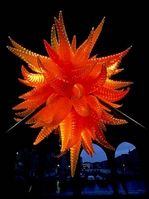In what must be one of the least satisfying copyright suits ever filed by a major artist, Dale Chihuly resolved his 14-month-long copyright dispute with glass entrepreneur Robert Kaindl more than two years ago. Earlier than that, glass art’s main man settled a similar suit with glass blower Bryan Rubino, who had worked for Chihuly for nearly a decade.
Both Rubino and Kaindl had counter sued. Suddenly, all suits were void, and terms of the settlements sealed. At the time, Chihuly said if it had it to do over, he wouldn’t.
To sue or not to sue. That is the question. I’m not the kind of person who wants to sue somebody, and yet I did. I got kind of fed up.
What was he fed up with?
I recently saw an ad for Kaindl in a luxury goods magazine. Here’s a piece from his Web site, followed by one from Chihuly’s. (Click on images to make them bigger.)
 That’s not all. When Chihuly Inc. announced its suit, press coverage
That’s not all. When Chihuly Inc. announced its suit, press coverage
tended to be sympathetic to the defendants (underdogs) rather than the
plantiff (top dog).
The worst offender was the Seattle Times. After six months of digging, the paper produced a bloated and inconsequential three-part Chihuly series.
It suggested grave wrongs were being uncovered at Chihuly Inc., maybe just over the hill of the next paragraph.
 As written by investigative reporter Susan Kelleher and art critic Sheila Farr, there was nothing but smoke over that hill. My favorite headline in the tell-all wannabe series was “Chihuly Benefits from his own Philanthropy.” Who doesn’t?
As written by investigative reporter Susan Kelleher and art critic Sheila Farr, there was nothing but smoke over that hill. My favorite headline in the tell-all wannabe series was “Chihuly Benefits from his own Philanthropy.” Who doesn’t?
Here’s how the ST framed the idea of the suit:
Headline: Chihuly turns up heat on competing artists.
Subhead: He’s been guarding his artistic style for years, warning others not to copy shapes and techniques he claims as his. But some say he’s gone too far with a copyright lawsuit.
That’s fair and balanced. Welcome to Seattle’s version of the no-spin zone.
My Chihuly profile here.
Fashion designers are more or less resigned to knockoffs, but artists aren’t. After Jeff Koons floated a basketball in a half-filled fish tank and called it a sculpture in the early 1980s, nobody rushed to market with the same idea. But Chihuly straddles two worlds, both art and craft. Like fashion, craft gets copied. Who hasn’t seen an imitation Tiffany lamp or an imitation Charles Eames’ chair?
What got lost in all this was art, but what chance does art have when conflict is on the table, along with juicy personal information and the opportunity to scorn a homegrown celebrity? None at all.
Time to move on. Chihuly has. But as I held Kaindl’s ad in my hands, the injustice of the outcome rankled.



Having taken a look at the work shown on Kaindl’s website, I doubt that Chihuly has anything to fear. Kaindl’s work is that of a mediocrity; Chihuly’s that of a truly great artist — a Rembrandt of glass.
It is unfortunate that so many people are willing to pay for what is at best second-rate work; Chihuly’s is the work that will endure, if that’s any consolation.
My sympathies were with the defendants here. Since Chihuly doesn’t do any of his own glass work all of the working decisions were left up to his contractors. The conceptions may be Dale’s but the actual objects are collaborations. The work is similar but Art historically feeds on itself and I don’t remember Duchamp ever suing Joseph Cornell. I suspect Dale found he had more to lose in the suit than he stood to gain. That’s control for you.
I agree with Alexis. There’s no comparison between the two. From the two images shows, Kaindl’s work is a banality at best – looks like dozens of other baubles available in tchotchke shops. It’s too bad to get sucked into lawsuits.
At best, what Dale Chihuly creates is decorative art, or craft, not art—or “fine art.” Few would dispute that we experience one of his works primarily on a sensory-perceptual level. No one would claim that, however, regarding a portrait by Rembrandt or a landscape by Bierstadt. We experience such works in large measure on a conceptual level—what comes across is what their maker values, or deems important, about life.
When we respond favorably to a work of art we do so because on a fundamental level it reflects our own values. One cannot say the same about the pleasure we might derive from a “piece” by Chihuly.
None of this is meant to denigrate the decorative arts, which have always played a crucial role in what makes life worth living. Their role in human life, however, is different from that played by fine art, and the distinction between the two merely an objective fact of reality.
Perhaps someone can tell me. Was there anything similar to Chihuly’s design/concept before Chihuly? If not, does that indicate that he was the creative force behind that look and does that give him some earned recognition of such? No doubt we will always have the appropriator, the copyist. That shouldn’t diminish Chihuly’s work. His only failure, in my mind, was to let the lawyers in. As to the 19th/20th century attitudes towards arts vs craft, floating a basketball in water is not necessarily art. It could just be a comment on gullibility.
“Art” like Chihuly’s looks commercially inspired. “Schlock” it’s called. Its sad that seemingly thinking people including his workers are blind to that. Or maybe they aren’t.
So sad that this is what amounts to scandal in this town. I want blood! Action! Acidity! I wanna see Kaindl go after Dale with a broken piece of sculpture while Dale throws molten glass! Whatever. Chihuly doesnt make it with his own hands so I have zero sympathy…
This is most unfortunate for all. Nevertheless the master has still won, though pained by the processe, money and time of jurisprudence. He wins because one IS a Chihuly and there is no mistaking the image comparisons. And one is derivative but attempting to be different. It is so obvious. And knows Chihuly DOES make the creative decisions (see a demo tape). Yet, because art is from art (and craft, if you wish to quibble), the slippery slope begins with influences from antecedents. Is the envelope pushed? Is the price game employed? What is inspiration and by whom, when, where, why, and how? Who used color first, or paint, &c? Does it matter?
Hell yes it does!
But satisfaction from the courts? Impossible! I’ve tried jurisprudence and found it wanting more than the cloistered world of the arts. Our languages will never correspond for an adequate understanding simply because the arts are emotive and that’s where the problems first started. To pin one as the underdog because the other is so established is as ludicrous as the writers/critics have shown their brittle emotive selves to be.
Over the plate,
HJ BOTT
Chihuly probably would have been best served leaving this alone in the first place, but I can see how he would get fed up with fabricators trying to steal his ideas and pass them off as their own.
But there really is a difference here. Kaindl’s pieces are made to fit anywhere – pick it off the shelf and take it home, a pretty bauble.
Chihuly’s work is true art – it responds to and is informed by its surroundings. Therein lies his genius, which has yet to be successfully copied.
Have any of you gone to one of Chihuly’s exhibits? If you did, you would realize that the ‘glass’ is the final part of an organic process. Dale visualizes the art in his head, and then translates those images into paintings (which are almost more amazing than the glass) then he works with his team to interpret the vision into glass. If you understand the entire process of each piece/series, you will know that his art really is his. As for Kaindl, his craft is in knocking off a master. There is no organic process to his work. He even has the gaul to use Dale’s series title for his own ‘collections’…tacky